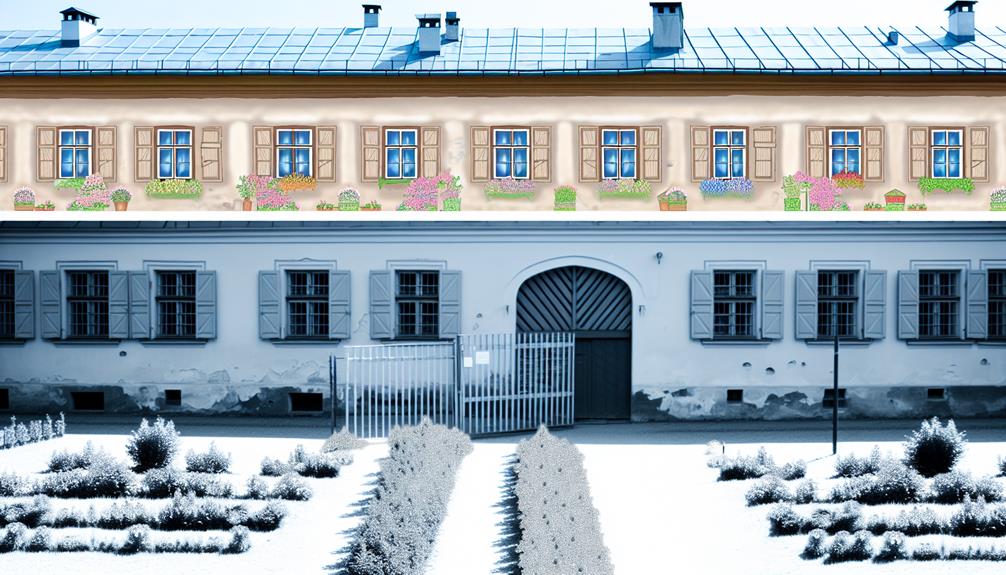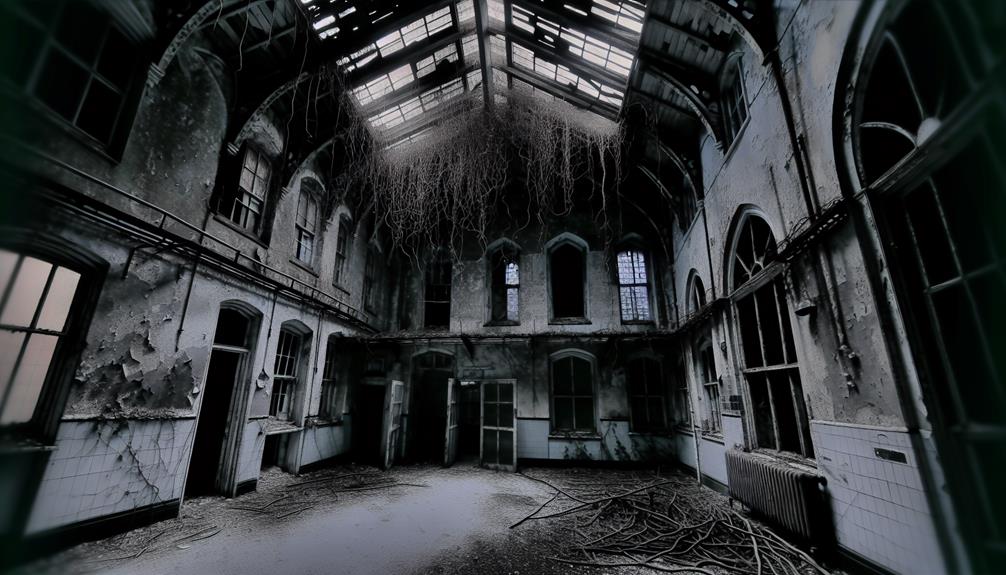Theresienstadt stands as a chilling example of the intricacies of deception woven into the fabric of the Nazi regime. As a purported model settlement, its facade masked the horrors unfolding within its walls. The manipulation of appearances and the selective narratives crafted to mislead outsiders about the true nature of the camp are a haunting reminder of the depths to which propaganda can sink. Understanding the dual existence of Theresienstadt invites contemplation on the complexities of historical narratives and the enduring impact of such deception.
Key Takeaways
- Theresienstadt used as a 'model Jewish settlement' for deception.
- Propaganda portrayed camp as cultural center to mislead.
- Selective displays hid harsh living conditions and true purpose.
- International Red Cross visit revealed overcrowding and poor conditions.
- Legacy emphasizes remembrance, education, and intolerance combat.
Historical Context of Theresienstadt
In order to fully understand the significance and impact of Theresienstadt as a Nazi concentration camp in the Czech Republic, it is essential to explore the historical context surrounding its establishment and operation. Theresienstadt, also known as Terezin in Czech, was established by the Nazis in November 1941, during their occupation of Czechoslovakia. Initially presented as a 'model Jewish settlement' to deceive the international community and cover up the true horrors of the Holocaust, it served as a transit camp for Jewish prisoners before they were sent to extermination camps in Eastern Europe.
The Nazi occupation of Czechoslovakia in March 1939 marked the beginning of the systematic persecution of Jews in the region. Theresienstadt, located in a garrison town built in the late 18th century, was repurposed by the Nazis to detain prominent Jews, intellectuals, and artists as a strategic move to exploit their talents for propaganda purposes. The camp's population swelled as more Jewish deportees arrived, leading to severe overcrowding and appalling living conditions.
Jewish prisoners in Theresienstadt were subjected to forced labor, malnutrition, and disease, with thousands perishing due to the harsh conditions. Despite the facade of cultural and recreational activities presented to visiting Red Cross officials, the reality was a grim existence marked by fear, suffering, and death for the inmates. The historical context of Theresienstadt underscores the insidious nature of Nazi propaganda and the atrocities committed against Jewish prisoners during the Holocaust.
Propaganda and Deception Tactics
The facade of Theresienstadt as a 'model Jewish settlement' intertwined with the grim reality of propaganda and deception tactics employed by the Nazis to obfuscate the true nature of the camp's operations. This manipulative approach aimed to create a false reality for external observers, including the International Red Cross, who visited the camp in 1944. Theresienstadt, often showcased as a cultural and artistic center, was strategically used by the Nazis to showcase a seemingly benign environment to deflect attention from the atrocities being committed there.
One of the key manipulative tactics used by the Nazis was the selective presentation of the camp during inspections. Buildings were hastily renovated, and the living conditions of prisoners temporarily improved to give the illusion of humane treatment. In reality, these efforts were a guise to hide the overpopulation, malnutrition, and inhumane treatment that were rampant in the camp on a daily basis. Additionally, the Nazis orchestrated a propaganda film titled 'The Fuhrer Gives the Jews a City' to further perpetuate the false narrative of Theresienstadt as a benevolent settlement.
Through these deceitful strategies, the Nazis managed to deceive many about the true nature of Theresienstadt, perpetuating a false reality that obscured the camp's actual purpose as a transit point to other extermination camps. The manipulation and deception tactics used at Theresienstadt highlight the insidious nature of Nazi propaganda and its role in perpetuating the Holocaust.
Life Inside the Camp
Within the confines of Theresienstadt, occupants were subjected to harsh conditions and a regimented daily routine that dictated every aspect of their existence. Life inside the camp was a constant struggle for survival. Prisoners had to develop various survival strategies to endure the brutal conditions imposed upon them by the Nazi regime. Despite the adversity, individuals within the camp formed strong community bonds as a means of emotional support and solidarity.
Survival strategies within Theresienstadt often revolved around resourcefulness and resilience. Prisoners had to find ways to obtain extra rations, navigate the crowded living conditions, and protect themselves from the physical and emotional hardships they faced daily. Some resorted to forming alliances with other inmates, sharing skills and knowledge to increase their chances of survival. Others engaged in small acts of kindness and solidarity to maintain a sense of humanity amidst the inhumane conditions.
Community bonds played a pivotal role in helping individuals cope with the extreme circumstances. Shared experiences created a sense of belonging and unity among the prisoners. These connections provided emotional support, camaraderie, and a semblance of normalcy in an otherwise dehumanizing environment. Through solidarity and mutual aid, the inmates of Theresienstadt found strength in each other, demonstrating resilience in the face of unimaginable adversity.
International Red Cross Visit
During the inspection conducted by the International Red Cross at Theresienstadt, a thorough evaluation of the camp's conditions and treatment of its occupants was meticulously documented. The visit by the International Red Cross aimed to assess the living conditions of the prisoners, the sanitation practices, and the overall well-being of those held within the camp's confines. The inspection findings revealed a stark contrast between the presented facade of Theresienstadt and the harsh reality of daily life for the prisoners.
The International Red Cross noted several concerning aspects during their visit to Theresienstadt. Despite attempts by the Nazis to disguise the true nature of the camp, the inspection findings exposed overcrowded living quarters, inadequate food provisions, and poor sanitation facilities. The Red Cross documented instances of malnutrition and disease among the prisoners, highlighting the inhumane conditions they were forced to endure.
Furthermore, the inspection findings raised questions about the discrepancies between the camp's portrayal as a 'model ghetto' for propaganda purposes and the actual suffering experienced by its inhabitants. The International Red Cross visit shed light on the deceptive practices employed by the Nazis to conceal the true atrocities occurring within Theresienstadt. This scrutiny by an international humanitarian organization brought attention to the need for greater oversight and intervention in the treatment of prisoners in Nazi concentration camps.
Legacy and Remembrance
Evaluating the enduring impact of Theresienstadt as a Nazi concentration camp in the Czech Republic reveals a complex interplay of historical remembrance and educational initiatives. The legacy impact of Theresienstadt extends beyond its physical presence, shaping how society reflects on the atrocities of the past and educates future generations. One way this is achieved is through memorial ceremonies, which serve as poignant reminders of the lives lost and the resilience of those who endured the horrors of the camp.
| Legacy Impact | Educational Initiatives |
|---|---|
| Serves as a solemn reminder of the Holocaust | Educational programs for schools |
| Honors the memories of the victims | Historical exhibitions |
| Encourages dialogue on the importance of remembrance | Survivor testimonies |
| Fosters a commitment to never forget | Research initiatives |
| Strengthens the resolve to combat intolerance | Preservation projects |
Memorial ceremonies held at Theresienstadt provide a space for collective mourning and reflection, fostering a sense of unity and shared history among participants. These events not only pay tribute to the victims but also underscore the significance of upholding the memory of the Holocaust for future generations. Through a combination of commemorative practices and educational efforts, Theresienstadt continues to serve as a powerful symbol of remembrance and a validation to the human spirit's enduring strength in the face of adversity.
Frequently Asked Questions
How Were Prisoners Selected for Deportation to Theresienstadt?
The selection process for deportation to Theresienstadt during the Nazi regime was meticulously planned, with criteria including age, health, and occupation. Elderly individuals, children, and those deemed unfit for heavy labor were often chosen.
The Nazis aimed to present Theresienstadt as a 'model ghetto' to deceive the international community, therefore selecting individuals who could potentially contribute to this façade. This process was part of the broader strategy to manipulate perceptions of the camp's true nature.
Did Any Prisoners Manage to Escape From Theresienstadt?
Escape attempts at Theresienstadt were rare due to the camp's high security and remote location.
Despite this, some prisoners displayed remarkable resilience and courage in their efforts to flee. A few managed to escape through daring schemes, utilizing forged papers or exploiting lapses in surveillance.
These instances of escape, while few in number, stand as a tribute to the indomitable human spirit and the lengths individuals will go to seek freedom amidst the horrors of confinement.
What Was the Impact of Theresienstadt on Survivors' Mental Health?
The impact of Theresienstadt on survivors' mental health was profound, resulting in severe psychological trauma. Many survivors experienced lasting effects, with survivor testimonies highlighting the enduring scars left by their time in the camp.
Coping mechanisms varied, with some individuals finding solace in sharing their stories, while others struggled with ongoing emotional distress. The long-term effects of Theresienstadt on survivors serve as a poignant reminder of the lasting repercussions of such traumatic experiences.
Were There Any Successful Resistance Movements Within the Camp?
Within the confines of various Nazi concentration camps, including Theresienstadt, prisoner solidarity played a pivotal role in fostering resistance movements.
In these dire circumstances, inmates often banded together to form underground networks, sharing information, resources, and support to defy their captors.
These acts of resistance, though risky, symbolized the resilience and unity of those imprisoned, showcasing the strength of the human spirit even in the face of unimaginable adversity.
How Did the Nazis Justify the Deception at Theresienstadt After the War?
Following World War II, the Nazis attempted to justify the deception at Theresienstadt through a web of propaganda and false narratives. Nazi propaganda aimed to portray the camp as a model settlement for Jewish individuals, distorting the reality of its purpose as a transit camp for deportation to extermination camps.
Post-war narratives sought to downplay the atrocities committed, emphasizing the alleged humane treatment of inmates to obfuscate the true horrors of Theresienstadt.
Conclusion
To sum up, Theresienstadt concentration camp in Czechoslovakia exemplified the deceptive tactics employed by the Nazis during World War II. Despite being presented as a model settlement, it was a transit point for Jews before their transfer to extermination camps.
The camp's legacy serves as a stark reminder of the inhumanity and deception of the Holocaust. One interesting statistic is that over 33,000 people died in Theresienstadt due to harsh living conditions and overcrowding.


